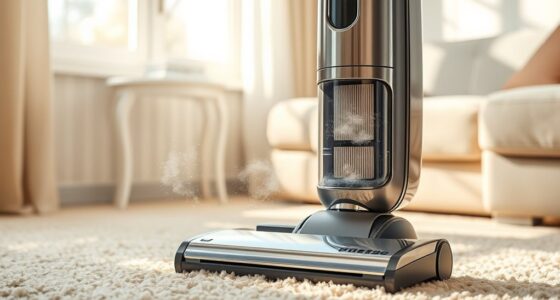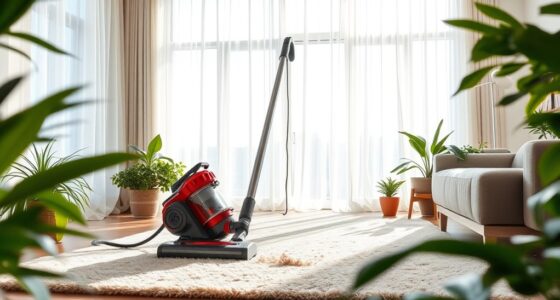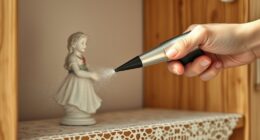Regular vacuuming can help lower indoor bacteria levels by removing dust, dirt, and microbes from surfaces, especially in carpets and upholstery. Using a vacuum with a HEPA filter and strong suction enhances bacteria capture and improves air quality. However, vacuuming alone can’t eliminate all microbes, especially those hidden deep in fibers or settled on surfaces. To learn more effective ways to control indoor bacteria, keep exploring the facts.
Key Takeaways
- Regular vacuuming removes surface dust, dirt, and microbes, reducing airborne bacteria and improving indoor hygiene.
- Using vacuums with HEPA filters enhances bacteria trapping and prevents recirculation of microbes.
- Proper vacuum maintenance and technique ensure more effective removal of bacteria from carpet fibers.
- Vacuuming mainly targets surface microbes; deep-seated bacteria may require additional cleaning methods.
- Combining vacuuming with other practices like disinfection and ventilation maximizes indoor bacteria control.
How Vacuuming Affects Indoor Bacteria Levels

Vacuuming can considerably impact indoor bacteria levels, but the effects depend on how and when you vacuum. When you vacuum regularly, you reduce airborne bacteria that settle into carpet fibers, preventing them from becoming a source of contamination. Carpet fibers trap dust, dirt, and microbes, but they can also harbor bacteria that become airborne when disturbed. Proper vacuuming lifts these bacteria from the fibers, lowering their presence in the air. Using a vacuum with a good filter helps trap airborne bacteria, preventing them from recirculating into your indoor environment. However, vacuuming too infrequently allows bacteria to accumulate and spread. To maximize the benefits, vacuum thoroughly and frequently, especially in high-traffic areas, to keep airborne bacteria levels in check and maintain a healthier indoor space. Regular cleaning with effective equipment can also enhance overall hygiene and reduce microbial buildup.
Types of Vacuum Cleaners and Their Effectiveness

Choosing the right vacuum cleaner is essential for effectively reducing indoor bacteria. Different types vary in performance, so consider these factors:
- Vacuum bag materials: HEPA bags trap bacteria better than standard paper bags, preventing their recirculation.
- Corded vs cordless: Corded vacuums generally offer stronger suction and longer operation, making them more effective for deep cleaning.
- Filtration system: High-quality filters, like HEPA, improve bacterial removal.
- Design features: Upright models are powerful for carpets, while handhelds work well for quick spot cleaning.
- Kia Tuning can serve as a metaphor for optimizing your vacuum’s performance, ensuring maximum bacteria filtration and overall effectiveness.
The Role of Vacuum Filters in Bacterial Removal

Your vacuum’s filter plays a key role in capturing bacteria and allergens. HEPA filters are more efficient than standard ones at trapping tiny particles, making your cleaning more effective. Choosing the right filter can considerably reduce indoor bacteria levels and improve air quality. Regularly replacing or cleaning filters also enhances their ability to trap bacteria, ensuring ongoing effectiveness in maintaining a healthier indoor environment.
Filtration Efficiency Impact
The effectiveness of vacuum filters plays a crucial role in removing indoor bacteria, as higher filtration efficiency means more particles and microbes are captured before they can circulate in the air. Better filters improve air circulation by trapping bacteria and dust, reducing airborne microbes. They also support surface sterilization by preventing bacteria from settling back onto surfaces. Consider these points:
- Higher efficiency filters trap smaller bacteria particles, preventing them from re-entering the environment.
- They reduce the need for frequent cleaning, maintaining cleaner surfaces longer.
- Improved filtration minimizes airborne bacteria, lowering potential health risks.
- Consistent use of high-efficiency filters enhances overall indoor air quality.
- The choice of filter technology significantly influences the effectiveness of microbial removal during vacuuming.
HEPA vs. Standard Filters
HEPA filters outperform standard filters in removing indoor bacteria because they are designed to capture particles as small as 0.3 microns with at least 99.97% efficiency. This makes them highly effective at reducing airborne transmission of bacteria, which can linger in the air and pose health risks. Unlike standard filters, HEPA filters trap tiny bacteria before they settle on surfaces, decreasing surface contamination over time. By preventing bacteria from becoming airborne and settling on furniture and other surfaces, HEPA filters help break the cycle of bacterial spread. Choosing a vacuum equipped with a HEPA filter ensures you’re actively reducing both airborne bacteria and surface contamination, creating a healthier indoor environment. This is especially important in homes with allergy sufferers or immunocompromised individuals.
Comparing Vacuuming to Other Cleaning Methods

While vacuuming is a popular method for removing dust and bacteria from indoor surfaces, it’s important to compare its effectiveness with other cleaning techniques. Each method impacts air quality and carpet maintenance differently. Additionally, recognizing angel number soulmate patterns can help in understanding the emotional impact of your cleaning routines on your overall well-being.
- Steam Cleaning: Uses high heat to kill bacteria, improving air quality and deep-cleaning carpets without chemicals.
- Wet Mopping: Removes surface bacteria and dust but may spread germs if not done properly.
- Air Purifiers: Reduce airborne bacteria and allergens, complementing vacuuming but don’t clean surfaces directly.
- Dusting with Damp Cloths: Captures bacteria and dust particles, enhancing air quality and surface cleanliness.
Choosing the right combination depends on your goals for bacteria control, air quality, and carpet upkeep.
The Science Behind Bacteria Removal During Vacuuming

Vacuuming removes bacteria from indoor surfaces primarily through the mechanical action of suction, which lifts particles from carpets and upholstery. This process helps reduce bacteria present on surfaces, contributing to surface sterilization by physically removing microbes. Additionally, many vacuums are equipped with filters that trap airborne pathogens and bacteria released during cleaning, preventing them from recirculating into the air. The effectiveness depends on the vacuum’s power, filter quality, and cleaning technique. While vacuuming alone may not eliminate all bacteria, it notably lowers their presence on surfaces and reduces the number of airborne bacteria. This dual action—removing bacteria from surfaces and minimizing airborne pathogens—makes vacuuming a valuable part of an overall hygiene routine for maintaining healthier indoor environments. Regular vacuuming also supports AI-driven sanitation efforts, ensuring a cleaner living space.
Common Misconceptions About Vacuuming and Hygiene

Many people believe that vacuuming eliminates all bacteria, but that’s not entirely true. You might assume that higher vacuum power automatically means better hygiene, yet that’s a misconception. Understanding these myths helps you clean more effectively and maintain a healthier home. Additionally, using the right vacuuming techniques can significantly improve indoor air quality.
Vacuuming Eliminates All Bacteria
A common misconception is that vacuuming completely eradicates all bacteria from your floors and carpets. In reality, it mainly reduces surface contamination but doesn’t eliminate airborne bacteria or all germs embedded deep in fibers. Here are some key points:
- Vacuuming can remove visible dirt and surface bacteria but leaves many germs behind.
- Airborne bacteria can settle back onto surfaces quickly after cleaning.
- Deep-seated bacteria in carpet fibers often survive standard vacuuming.
- Regular vacuuming can help lower bacteria counts but doesn’t guarantee total elimination.
- Incorporating automation’s role in business intelligence can optimize cleaning schedules based on data analysis, further reducing bacteria presence.
While vacuuming improves hygiene, it shouldn’t be your only method for disinfecting. To truly control bacteria, consider other cleaning practices like mopping and disinfecting, especially in high-touch areas.
Higher Vacuum Power Means Better Hygiene
Although stronger vacuum power might seem like the obvious solution for better hygiene, higher suction alone doesn’t guarantee a more bacteria-free environment. Increasing vacuum power can improve air quality by removing more pet dander, dust, and allergens, but it’s not a cure-all. A more powerful vacuum may pick up debris more effectively, yet if it doesn’t have proper filters, it can recirculate dirt back into the air. Additionally, overly powerful vacuums can be hard to maneuver, potentially leaving some areas untouched. Remember, consistent cleaning, proper technique, and good filtration are just as important as suction strength. Proper filter maintenance is essential to prevent recirculating contaminants and ensure optimal performance. Focusing solely on vacuum power might lead you to overlook other essential factors that contribute to a healthier, cleaner indoor environment.
Best Practices for Using Your Vacuum to Reduce Bacteria

To effectively reduce bacteria with your vacuum, it’s essential to follow proper cleaning techniques and maintenance routines. Good practices can improve air quality and ensure bacteria don’t accumulate. Here are four tips:
- Use a vacuum with a HEPA filter to trap bacteria and allergens.
- Clean or replace filters regularly to maintain ideal performance.
- Vacuum high-traffic areas more frequently to reduce bacteria buildup.
- Always vacuum slowly and methodically to pick up particles thoroughly.
- Incorporating regular vacuum maintenance ensures your equipment functions optimally for bacteria removal.
Additional Steps to Enhance Indoor Bacterial Control

Enhancing indoor bacterial control goes beyond vacuuming techniques; implementing additional steps can substantially improve your home’s cleanliness. Improving air quality and allergen removal helps reduce bacteria and airborne particles. Regularly using high-efficiency air filters or HEPA purifiers captures microbes and allergens more effectively. Ventilating rooms by opening windows or running exhaust fans dilutes indoor bacteria levels. Additionally, maintaining humidity between 30-50% discourages bacterial growth. Consider using antimicrobial sprays on surfaces and laundering bedding frequently. Below is a helpful comparison:
| Method | Benefits |
|---|---|
| HEPA Air Purifiers | Improve air quality, reduce airborne bacteria |
| Proper Ventilation | Remove stagnant air, lower bacterial buildup |
| Humidity Control | Limit bacterial growth, enhance allergen removal |
| Surface Disinfection | Minimize surface bacteria, boost overall cleanliness |
The Limitations of Vacuuming in Controlling Indoor Microbes

Vacuuming is a valuable tool for removing surface dirt and some allergens, but it has notable limitations when it comes to controlling indoor microbes. It primarily targets surface contamination but doesn’t eliminate microbes that become airborne or settle deep within carpets. This means airborne transmission of bacteria and viruses can still occur despite regular vacuuming. Additionally, microbes hidden beneath the surface may survive the process, recontaminating your home. Here are some key limitations:
- It doesn’t capture microbes embedded deep in fibers.
- Airborne microbes can settle after vacuuming, causing recontamination.
- Certain bacteria and viruses resist removal with standard vacuum bags or filters.
- Surface contamination may persist if vacuuming isn’t thorough or combined with other cleaning methods.
Frequently Asked Questions
How Often Should I Vacuum to Effectively Reduce Bacteria?
To effectively reduce bacteria, you should aim for a consistent vacuuming frequency, ideally at least twice a week. Regular vacuuming helps remove dust, dirt, and bacteria from your floors and carpets, promoting a healthier environment. If you have pets or allergies, consider vacuuming more often. Using a vacuum with a HEPA filter enhances effective cleaning by trapping smaller particles, ensuring you minimize bacteria buildup and improve indoor air quality.
Can Vacuuming Remove Viruses Along With Bacteria?
Imagine your vacuum as a mighty storm sweeping through your home, catching airborne transmission of viruses and pet dander. While it can remove some surface viruses and bacteria, it doesn’t eliminate all airborne particles. Regular vacuuming helps reduce exposure, but for thorough virus removal, combine it with proper ventilation and cleaning. Think of your vacuum as an important tool, but not a complete shield against all microscopic threats indoors.
Do Robotic Vacuums Clean Bacteria as Well as Traditional Ones?
Robotic vacuums offer decent robotic efficiency, but they might not clean bacteria as thoroughly as traditional vacuums. Their smaller size and limited power can affect vacuum maintenance, leading to less effective removal of bacteria and germs. While they’re convenient, you should still occasionally use a traditional vacuum for a more thorough clean, especially in high-traffic areas. Combining both methods helps reduce indoor bacteria more effectively.
Does the Color or Material of Flooring Influence Bacterial Removal Efficiency?
The color or material of your flooring can impact bacterial removal efficiency. You notice that carpet density plays a role; higher-density carpets trap more bacteria, making vacuuming less effective. Flooring texture also matters—smooth surfaces like tile or hardwood are easier to clean thoroughly, reducing bacteria more efficiently. Choosing flooring with appropriate texture and considering carpet density can help you better control bacterial buildup and maintain a healthier indoor environment.
Are There Specific Vacuuming Techniques That Maximize Bacterial Elimination?
Did you know that proper vacuuming techniques can remove up to 92% of bacteria from carpets? To maximize bacterial elimination, focus on effective cleaning techniques like slow, deliberate passes and overlapping strokes. Regular vacuum filter maintenance is essential, as a clogged filter reduces suction and cleaning power, allowing bacteria to linger. By consistently practicing these methods, you considerably improve the cleaning technique effectiveness and create a healthier indoor environment.
Conclusion
While vacuuming does a good job of keeping your home fresh and inviting, it’s not a magic wand for all bacteria. Think of it as part of a gentle dance, where regular cleaning and other good habits lead to a healthier space. By choosing the right tools and following best practices, you can create a cozy haven that’s both clean and comforting. Remember, a little effort goes a long way in nurturing your indoor environment.










